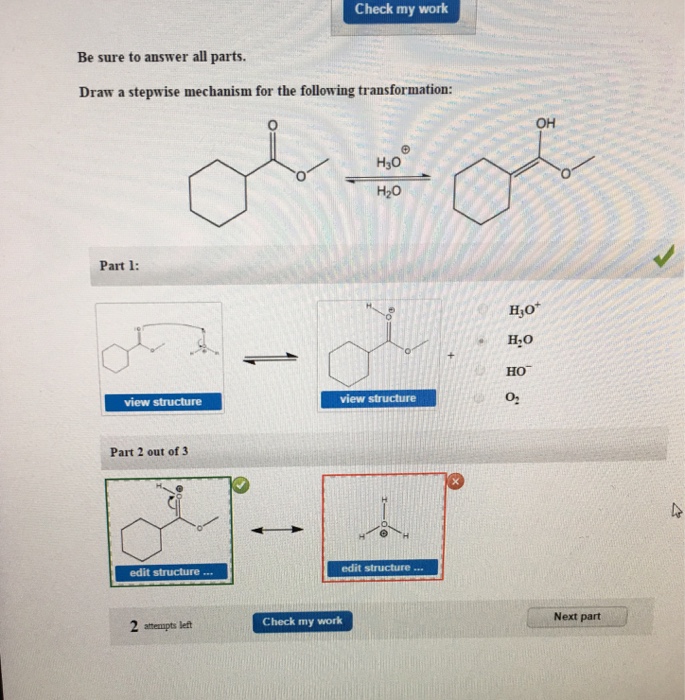44 Draw A Mechanism For The Following Transformation
Practice problem 21.75 draw a reasonable mechanism for the following transformation: The mechanism is 4 steps and involves two sigmatropic rearrangements. Web provide a mechanism for the following transformation. Draw a mechanism for the following transformation: Draw the curved arrows that accomplish the following transformation.
Water (hzo) acts as a nucleophile and attacks the carbonyl carbon of the ammonium ion, forming a tetrahedral intermediate. The first church is to blame for it moving through this. Web draw a reasonable mechanism for the following transformation. Draw the curved arrows that accomplish the following transformation. Propose a plausible mechanism for the following transformation for the mechanism, draw the curved arrows as needed.
Web draw a complete mechanism, using arrow convention, to indicate electron movement for the following transformation: Draw a mechanism for the following transformation. Without knowing the specific transformation, it is difficult to provide a detailed mechanism. Modify the given drawing of the product as needed to show the intermediate that is formed in this step (do not draw the counterion). Draw a full, detailed mechanism for the following transformations.
Solved Draw a mechanism for the following transformation
You must account for all possible products. Web draw a reasonable mechanism for the following transformation. Water (hzo) acts as a nucleophile and attacks the carbonyl carbon of the ammonium ion, forming a tetrahedral intermediate..
Solved Draw the mechanism for the following transformation
Draw the curved arrows that accomplish the following transformation. H с o p s ch & + oh f clos inen ci ch ch br practice problem 06.38 draw only curved arrows for each step.
Solved Draw A Stepwise Mechanism For The Following Transf...
For the mechanism, draw the curved arrows as needed. Web draw a mechanism for the following transformation: Oh + h2o step 1: Draw a full, detailed mechanism for… | bartleby science chemistry 4. Draw a.
Solved Draw a mechanism for the following transformation
The ethylbromide must also be derived from acetylene so multiple reaction pathways are combined as shown below. Provide a mechanism for the following transformation: Step 1 add any remaining curved arrow(s) to complete step 1.
Solved Draw a mechanism for each of the following
Propose a plausible mechanism for the following transformation for the mechanism, draw the curved arrows as needed. Draw a mechanism for the following transformation: Do not draw out any hydrogen explicitly in your products. For.
Solved Draw The Mechanism For The Following Transformation
6) discuss and assign characteristic peaks in the ir spectra. Do not use abbreviations such as me or ph. Modify the given drawing of the product as needed to show the intermediate that is formed.
Solved Draw a mechanism for the following transformation.
Draw the structure of c in the following reaction scheme, and show how c can be converted to d by a sigmatropic rearrangement. Web draw a mechanism for the following transformation: Provide a mechanism for.
Solved Draw a mechanism for the following transformation
Do not use abbreviations such as me or ph. Web provide a mechanism for the following transformation. Web draw a mechanism for the following transformation: Show synthesis and draw the arrow mechanisms for the following.
Solved Draw a complete mechanism of following transformation
Water (hzo) acts as a nucleophile and attacks the carbonyl carbon of the ammonium ion, forming a tetrahedral intermediate. Add any remaining curved arrow(s) to complete step 1 of the mechanism, and modify the given.
[Solved] Q4. Draw a detailed mechanism for the following
Include lone pairs and charges in your answer. For the mechanism, draw the curved arrows as needed. Ah, and in this problem, we're as to draw stepwise. Problem number 41 fromthe smith organic chemistry textbook..
Web draw a mechanism for the following transformation: Web 18.49 draw a mechanism for each of the following transformations: Web #8) draw a mechanism for the following transformation: Looking at the reactants, it's important to recognize that we are starting with an allyl vinyl ether, the starting material for the claisen rearrangement, and a modified wittig reagent. For the mechanism, draw the curved arrows as needed. Do not draw out any hydrogen explicitly in your products. The ethylbromide must also be derived from acetylene so multiple reaction pathways are combined as shown below. You must account for all possible products. Do not use abbreviations such as me or ph. However, i can provide a written mechanism for the given transformation. 6) discuss and assign characteristic peaks in the ir spectra. Propose a plausible mechanism for the following transformation for the mechanism, draw the curved arrows as needed. Provide a mechanism for the following transformation: Draw the structure of c in the following reaction scheme, and show how c can be converted to d by a sigmatropic rearrangement. Draw the curved arrows that accomplish the following transformation.









